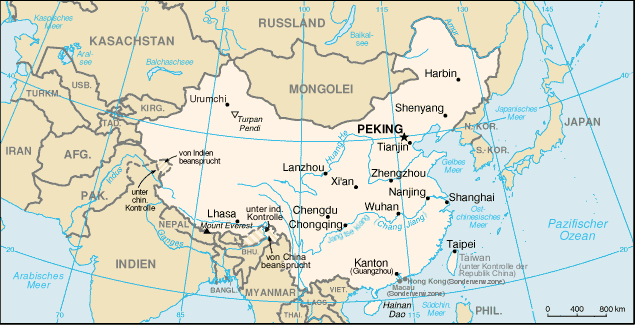
So I’ve been in Beijing for all of two weeks and now I have a one-week holiday because of the “Golden Week” of the National Day holiday. What’s that you might ask? The “Golden Week” refers to the 7 days off that the Chinese take to commemorate the founding of the People’s Republic of China (not to be confused with the Republic of China, aka Taiwan, and also a very sensitive subject I’m told). It was on October 1, 1949 at 3 pm that Chairman Mao read the declaration of the PRC and waved the five-star red flag that we now associate with the country. I hope to head over to Tien An Men Square to see what’s going on there but I couldn’t find anything online or in print that would give me times and places for any celebrations. In any event, it might be cool to check out.
This post is a small collection of articles that I’ve read recently that describe the current goings-on in China. I’ll post a little later about my impressions of the country so far.
The Beijing Review had an article commemorating the 65th anniversary of the founding of the PRC and summarizes the current reforms that the government is putting in place. Here are my notes from the article if you don’t have the time to read it through on your own. The article was written by journalist Li Li for the English expat community in Beijing.
- China’s “new normal” – over four decades of growth from 1978 until now is no longer feasible, sustainable or necessary. Instead, the government is looking for efficiency and quality, pushing forward reform, adjusting structure and improving people’s lives.
- The third plenary session of the 18th CPC Central Committee in November 2013: abolished the four-year detention without trial, allowed parents to have more than one child if they are an only child in their family lineage. Restrictions were lifted on minimum registered capital, payment deadlines and cash ratio of registered capital so as to encourage startups.
- China is opening itself to private investors in oil and natural gas exploration and the banking sector, two areas that were the exclusive realm of the government. (Is this similar to India’s slow release of their government-held companies, ie, airlines?) Railways are also being opened to private investors while reforms in the agricultural products and public service products.
You can read the full article on the Beijing Review website: Li Li. “A New Start for Change.” Beijing Review. Vol. 57, No. 40, October 2, 2014. http://www.bjreview.com.cn/quotes/txt/2014-10/01/content_641941.htm. Accessed 1 October 2014.
The latest issue also included a short piece by the Editor, which I summarize below:
- As China moves into the “…key last half of its 100-year modernization efforts” and now has a “democratic political system”, the country is striving to change the world’s perception of “Made in China” to “innovated in China”. Finally, the “Chinese dream” features “national prosperity, renewal and improved livelihoods.” (Editor’s Desk)
Another article I found useful was posted on the STRATFOR website titled “Urbanization and Demographics Could Skew China’s Economic Rebalancing“. The summary (as taken from their website) is as follows:
China’s urban population may grow by as many as 230 million people in the next 15 years. But most growth will take place not in metropolises like Beijing, Shanghai and Chongqing but in the myriad small- and medium-sized satellite cities around them. And as residents flock to these cities, China’s working-age population will begin to decline, and its elderly population will grow dramatically.
Together, these processes will underpin major changes not only in China’s overall economic structure, but also in the financial, fiscal and political relationship between central and local government. The added burdens facing small- and medium-sized cities, especially those located deep inside China that are sequestered from mainstream global trade, will be substantial and perhaps socially and politically destabilizing.
The full article can be found on STRATFOR’s website.
And if you’re interested in some Chinese history and can’t be bothered to read through the Wikipedia entry, then maybe the Crash Course video series on YouTube (which is blocked in China) will help. The first video squeezes in 2,000 years of Chinese history in a 12 minute video while the second video discusses the revolution that led to Chairman Mao being instantiated as the country’s leader.
[youtube]http://youtu.be/ylWORyToTo4?list=PLBDA2E52FB1EF80C9[/youtube]
[youtube]http://youtu.be/UUCEeC4f6ts?list=PLBDA2E52FB1EF80C9[/youtube]
Hope that helps you understand a little more about China and how the country is maneuvering the waters of economic expansion and a growing population.